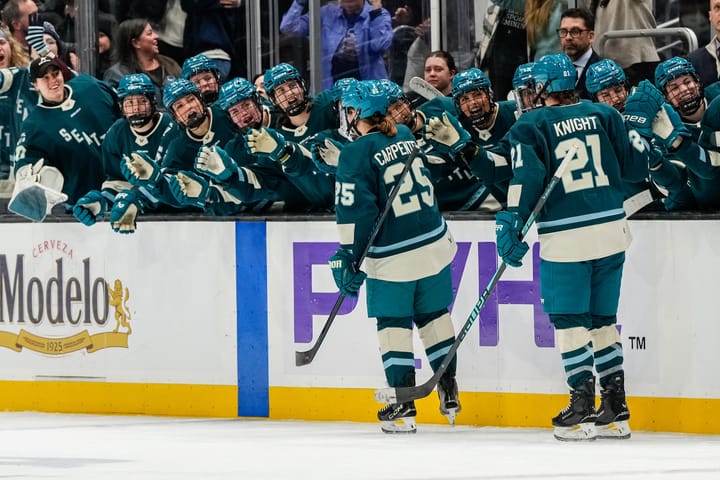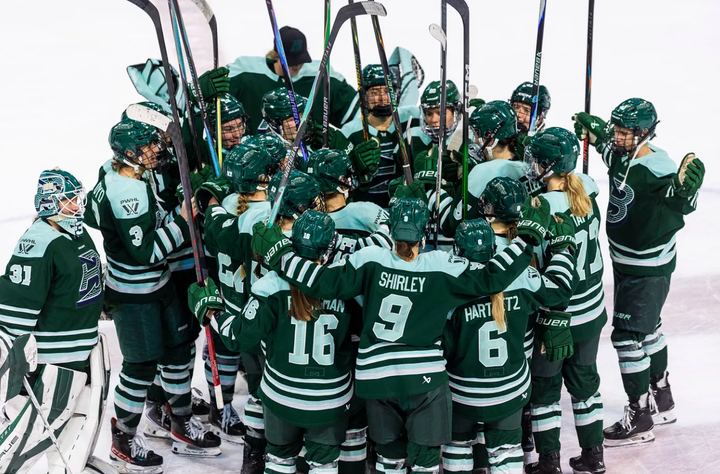If Team USA was a soccer starting 11
It’s the World Cup, and we were feeling a little left out over here
One of the growing opinions about the development of young athletes is that they should diversify the sports that they play, rather than focusing on just one — and that they should specialize later. Many of the players on National Teams have experience playing several sports, and soccer is a fairly popular choice.
Going through the rosters for Team USA over the last few years, I have compiled what I consider an ideal Starting XI out of players who have played soccer in the past. I’ll break down my choices below.
GOALKEEPER: Nicole Hensley
A good goaltender is crucial to a team’s success ... obviously. Because the nets in soccer are so big (8 yards wide, 8 feet tall), good positioning is probably the No. 1 skill that a soccer goalie has to master. It’s important in hockey, too, but sufficiently aggressive or flexible goaltenders can compensate for mediocre positioning — not so in soccer. Hensley is a very solid, well-positioned goalie. She’s a bit short for soccer goalies, but I think she could handle it regardless.
FULLBACKS: Monique Lamoureux-Morando and Gigi Marvin
In a 4–4–2 formation, the fullbacks play wide defense. Or, depending on the style of play/coaching, they play wide “defense.” That is, it’s defense in the way that a puck-moving offensive defender plays defense — by creating offense. Lamoureux and Marvin are both players who have excelled as defenders and as forwards. They’re highly physical players who can win one-on-one battles for the puck (or ball, in this hypothetical), and have the vision to find their teammates in the midfield to start the attack.
(Disclaimer: I can’t find proof anywhere that Marvin played soccer in high school, but I’m 99% sure it happened and 99% sure I know that because it was mentioned somewhere at some point. In the event that I’m wrong, she’s the honorary addition to the roster.)
CENTER-BACKS: Lee Stecklein and Shelly Picard
Being tall is a huge plus for a center-back. That’s not the only reason I chose Stecklein, but it definitely helps. Center-backs are not playmakers — that’s what the wide defenders (fullbacks) are for. If the goalie is your last line of defense, your center-backs are the second-to-last. With the wide defenders pushing forward, center-backs act the way that stay-at-home defenders do in women’s hockey: stepping to the attacking players and clearing the ball out of the center of the field. Both Stecklein and Picard are known for their defensive abilities, including positioning, which is a large part of a center-back’s job. They have both also acted as captains and alternate captains in their careers (Picard with Harvard and the NWHL’s Riveters, Stecklein with the Minnesota Golden Gophers), which proves that they have the ability to organize their back line (and the rest of the team during free kicks or corner kicks).
DEFENSIVE MIDFIELDER: Meghan Duggan
In a 4–4–2 formation, you will generally see midfielders play in a diamond. The central midfielder who plays behind (at the “bottom” of the diamond) is the defensive midfielder. Obviously, defense is an important skill for this player. Duggan is a great two-way player, who pairs her impressive scoring ability (36 points in 30 NWHL games; 238 points in 159 NCAA games) with defensive awareness and the willingness to jump into the play on both sides of the puck (or ball).
ATTACKING MIDFIELDER: Hayley Scamurra
The player who plays at the “top” of the diamond is the attacking midfielder. One of the most important things an attacking midfielder can possess is a great first touch. Scamurra has an incredible ability to possess the puck, turn with it immediately, and bring it into the offensive zone. More than that, she’s a physical enough player that she can hold off more than one defender while she waits for her teammates to get into position. Over the past two seasons in the NWHL, and during the most recent Worlds, the number of goals and number of assists she’s earned have been dead equal, which just goes to prove my point: she’d be a great attacking midfielder because she can control and create attacking plays, and she can finish them.
MIDFIELDERS: Hannah Brandt and Kelly Pannek
All midfielders have to be good at creating scoring chances. Midfielders in particular have to be very comfortable under pressure — able to shield the ball from the other team’s midfield and defenders. Both Brandt and Pannek are extremely capable playmakers whose skill is matched by their physical ability to be strong on the puck. They’d be good midfielders because they’d be strong on the ball and possess the vision to find open teammates and organize structured attacks in the run of play while handling pressure from defense.
FORWARDS: Jocelyne Lamoureux-Davidson and Sydney Brodt
Forwards are, above all else, goal scorers. We all already know that Jocelyne Lamoureux has an incredible finishing ability. Brodt proved during Four Nations that when she’s paired with players who can feed her, she has a very reliable scoring touch, as well. Speed is another attribute that’s incredibly important for forwards, and anyone who watched Brodt during Worlds this year knows how fast she can be.
I’m not really sure what that gold-medal-winning deke would look like in soccer, but I do know it would be amazing.





Comments ()